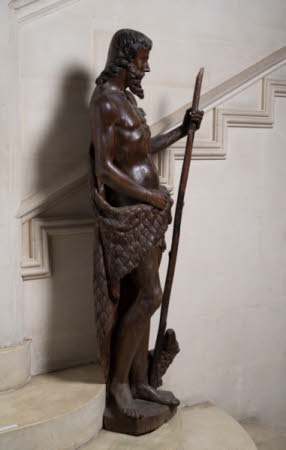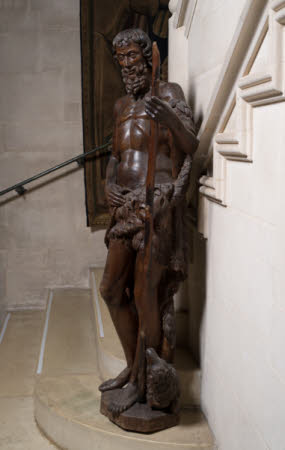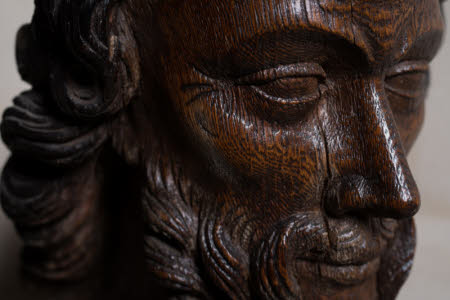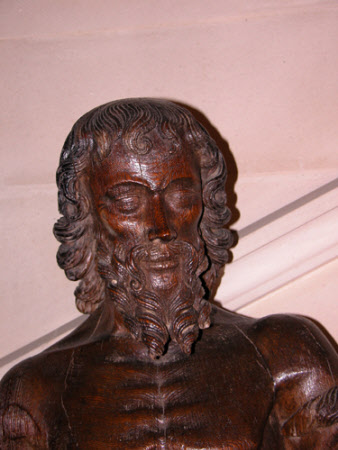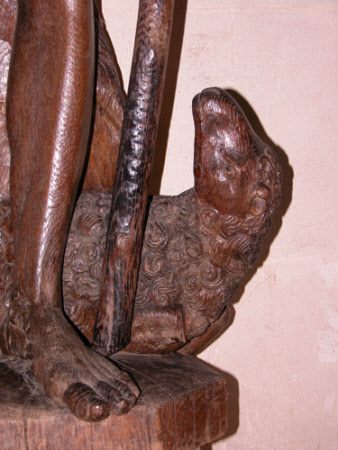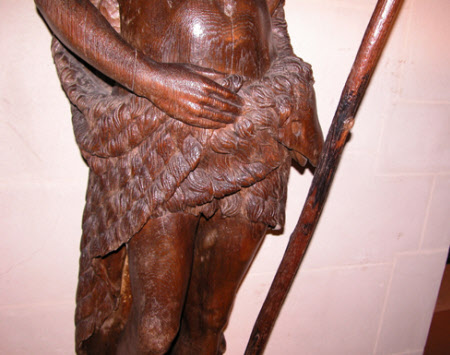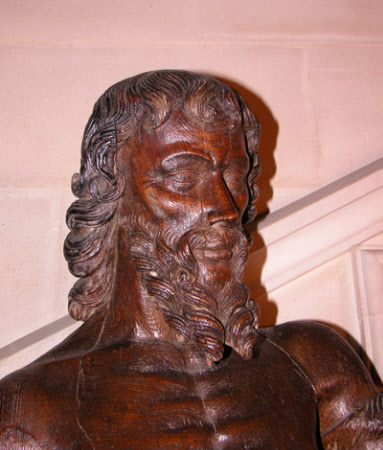Saint John the Baptist
probably Flemish
Category
Art / Sculpture
Date
c. 1550 - 1650
Materials
Oak
Measurements
1490 x 425 x 301 mm
Place of origin
Netherlands
Order this imageCollection
Anglesey Abbey, Cambridgeshire
NT 514369
Summary
Oak wood; Saint John the Baptist; probably Southern Netherlandish (Flemish); c. 1550-1650. A near life-size oak carved statue of Saint John the Baptist, standing and dressed in his animal skin, holding a staff and with the lamb at his feet. Although the use of oak would suggest it was made in Northern Europe, probably in the Low Countries, this large and impressive figure is strongly Italianate in style. It may have been made during the second half of the sixteenth century.
Full description
A near life-size oak carved statue of Saint John the Baptist, depicting the saint standing, naked except for an animal skin wrapped around him, his right hand at his waist, his left holding a staff. At his feet is the lamb. A small half-octagon integral wooden base. The sculpture is roughly hollowed out at the back and is flattened at back, confirming that it was made to stand against some form of wall. It is largely made from a single large piece of wood, to which some sections have been added, notably on the figure’s left side: part of left shoulder, arm and the animal skin in this area; right arm from shoulder to wrist. It is in relatively good condition, with some vertical splits in the wood. Repairs include a patch in the left foot. This large and impressive sculpture is a striking image of John the Baptist, the forerunner of Christ, showing him as a young man in the desert. John’s prophesying is recounted or alluded to in all four of the Gospels: 'In those days came John the Baptist, preaching in the wilderness of Judaea, And saying, Repent ye: for the kingdom of heaven is at hand. For this is he that was spoken of by the prophet Esaias, saying, The voice of one crying in the wilderness, Prepare ye the way of the Lord, make his paths straight. And the same John had his raiment of camel’s hair, and a leathern girdle about his loins; and his meat was locusts and wild honey.' (Matthew 3, 1-4). In line with the biblical descriptions, the prophet is depicted here as a somewhat gaunt and emaciated figure, who nevertheless radiates serenity through his calm gaze. The naturalistic carving of the animal skin, which even includes the head of the ram on Saint John’s left flank, is also remarkable. Overall, the sculpture is very well carved, the sculptor working the natural grain of the wood to help shape the musculature of the body, for example on the chest. The conception of this sculpture, a commanding, somewhat idealising standing figure is strongly Italianate. If oak were not such a rare material for wood carving in Italy, it would certainly be regarded as Italian, but because of the material, the commonly-used wood for carving sculptures in Northern Europe, an origin north of the Alps, perhaps in Flanders, must be considered more probable. However, if this is the case, the sculptor is very likely to have spent time in Italy. The sculpture seems though to show knowledge of the standing figures of John the Baptist and of Mary Magdalen, which in the fifteenth and sixteenth centuries became something of a feature of Florence, a city whose patron saint is John the Baptist. The earliest, and one of the very greatest such sculptures, is the polychromed and gilded wooden statue by Donatello (c. 1386-1466) made for the basilica of the Frari in Venice in 1438 (Bonnie A. Bennett and David G. Wilkins, Donatello, Oxford 1984, pp. 129-32, 188-89, figs. 113-14; Alfredo Bellandi, ed., “Fece di scoltura di legname e colori”. Scultura del Quattrocento in legno dipinto a Firenze, exh. cat., Gallerie degli Uffizi, Florence 2016, pp. 164-65, no. 2). In around 1457, Donatello made an even more gaunt and expressionist figure of the Baptist in bronze for the Baptistry of Siena Cathedral (Bennett and Wilkins, pp. 117-20, fig. 65). From elsewhere in Italy, an expressive full-length standing figure made c. 1470 in terracotta by the Paduan sculptor Giovanni Fonduli (active 1460s, died before 1497) is in the Detroit Institute of Arts (Inv. 22.2. Alan P. Darr, Peter Barnet and Antonia Boström, Catalogue of Italian Sculpture in the Detroit Institute of Arts, 2 vols., London/Turnhout 2002, I, pp. 175-77, no. 87). In the early sixteenth century, this tradition continued, with powerful life-size standing figures of the Baptist in wood being made by Francesco da Sangallo (c. 1515-20, Pieve di San Romolo, Bivigliano, Florence; “Fece di scoltura di legname e colori”, pp. 218-19, no. 29) and by Giovanfrancesco Rustici (c. 1505; Church of San Martino, Abeto di Preci, Perugia; “Fece di scoltura di legname e colori”, pp. 250-51, no. 44). Jeremy Warren November 2021
Provenance
Urban Huttleston Rogers Broughton, 1st Lord Fairhaven (1896-1966), acquired before 1932; Anglesey Abbey inventory 1932, p. 30, Entrance Hall, ‘An old carved wood figure – St. John the Baptist’, valued at £30; Anglesey Abbey inventory 1940, p. 218, Garden Hall by Dining Hall, ‘An Ancient carved wood figure – The Good Shepherd', valued at £30; bequeathed in 1966.
Makers and roles
probably Flemish, sculptor Italian (North Italian) School, sculptor
References
‘Anglesey Abbey, Lode, Cambridgeshire. An Inventory and Valuation of Furniture, Pictures, Ornamental Objects, Household Effects and A Collection of Miniatures.. prepared for Insurance Purposes’, Turner, Lord and Ransom, November 1932, p. 30. 'Anglesey Abbey, Lode, Cambridgeshire. An Inventory and Valuation of Furniture, Books, Ornamental Items & Household Effects .. prepared for Insurance Purposes’, Turner, Lord and Ransom, April 1940, p. 218. Hussey 1954: Christopher Hussey, ‘A Fenlandscape Garden – II: Anglesey Abbey, Cambridgeshire, the Home of Lord Fairhaven’, Country Life, 25 March 1954, pp. 860-63., p. 862, fig. 8.
